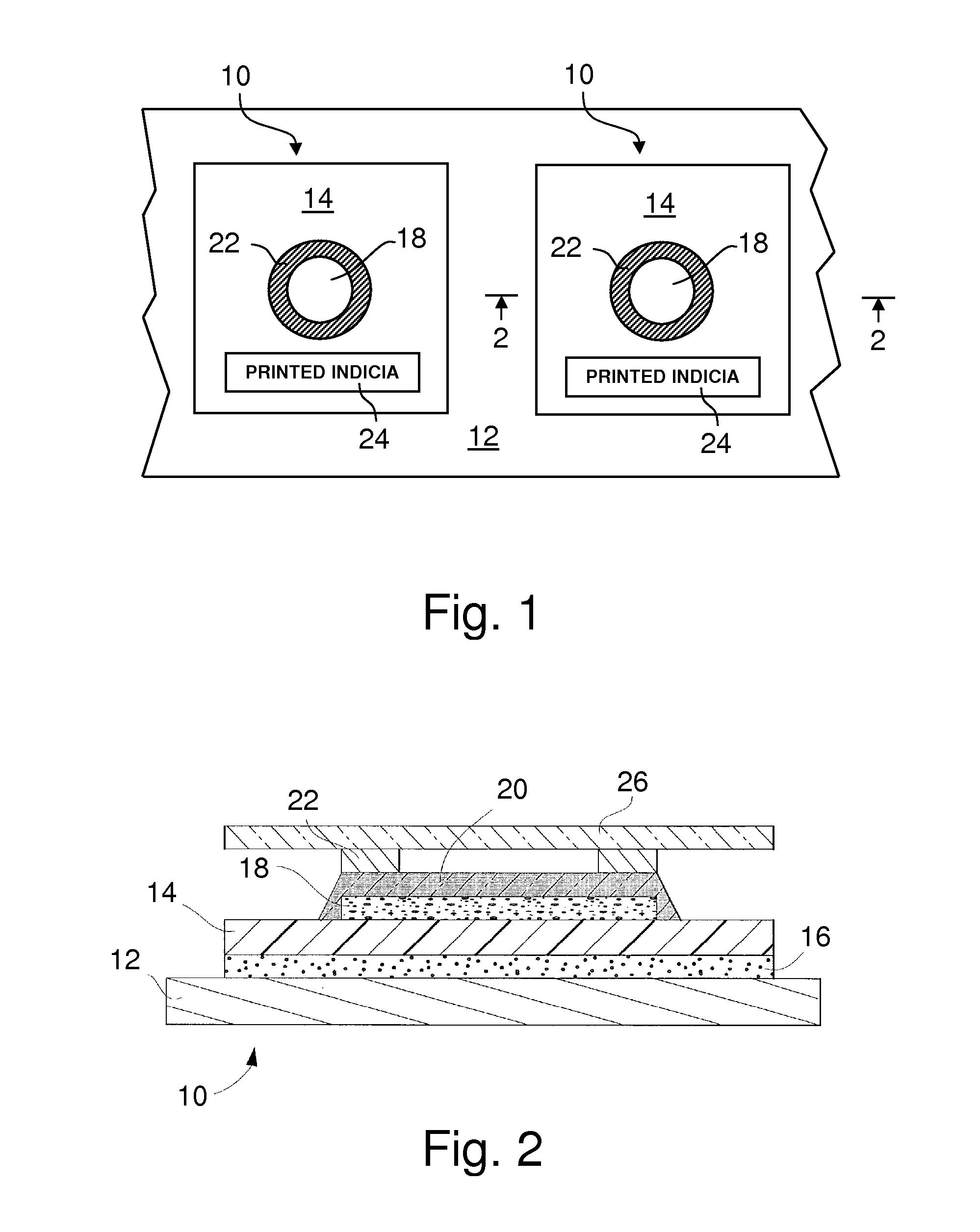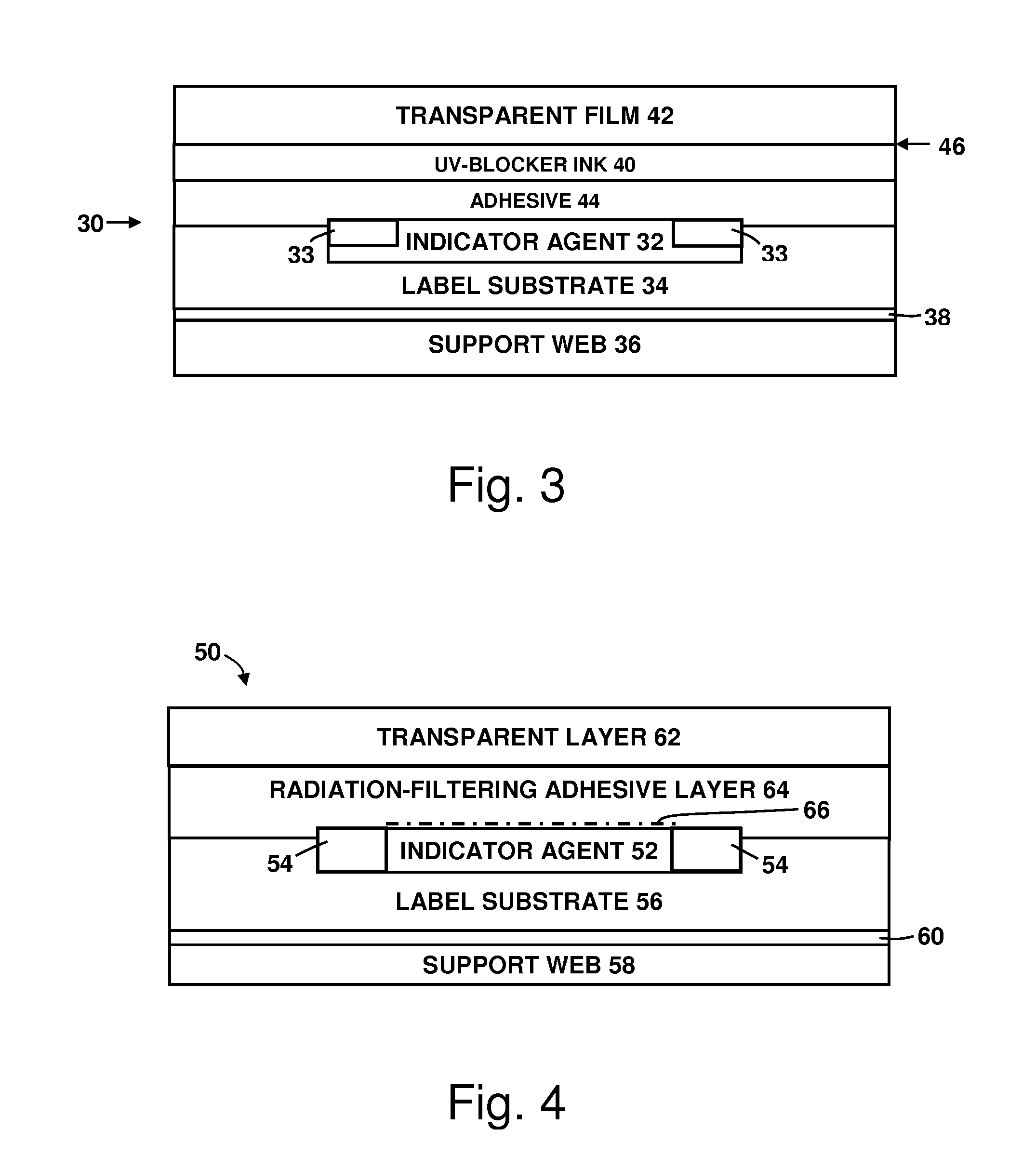Robust, ultraviolet-protected ambient condition history indicator and method of making same
a technology of ultraviolet protection and ambient condition, applied in the direction of chemical indicators, instruments, paper/cardboard containers, etc., can solve the problems of environmental ultraviolet radiation exposure, and achieve the effect of good ultraviolet protection and easy manufacturing
- Summary
- Abstract
- Description
- Claims
- Application Information
AI Technical Summary
Benefits of technology
Problems solved by technology
Method used
Image
Examples
example 1
[0185]A radiation-filtering adhesive of coatable consistency is prepared by thoroughly mixing the following ingredients, in the proportions indicated, and in the sequence listed, which proportions are based on the weight of the radiation-filtering adhesive: 10 parts by weight of solvent-based acrylic copolymer adhesive (dissolved in a mixture of toluene, ethyl acetate, and ethanol, with a solids content of about 44.6 percent by weight) available from Cytec Industries inc. West Paterson, N.J. under the trademark GELVA®, product code 2495;[0186]1.18 parts by weight of 2-ethylhexyl-2-cyano-3,3-diphenylacrylate, which is an organic ultraviolet light absorber available from BASF Aktiengesellschaft, Ludwigshafen, Germany under the trademark UVINUL® 3039;[0187]0.31 parts by weight of orange G dye available under the trademark ORASOL®;[0188]0.61 parts by weight of yellow dye also available under the trademark ORASOL®;[0189]0.84 parts by weight of 2,2′-dihydroxy-4-methoxybenzophenone, an org...
example 2
[0192]Example 1 is repeated employing the following ones of the ingredients used in Example 1, in the proportions indicated below:[0193]73.4 parts by weight of solvent-based acrylic copolymer adhesive (solids content 44.6 percent by weight);[0194]10.0 parts by weight of 2-ethylhexyl-2-cyano-3,3-diphenylacrylate;[0195]7.1 parts by weight of 2,2′-dihydroxy-4-methoxybenzophenone;[0196]5.2 parts by weight of yellow dye; and[0197]4.3 parts by weight zinc oxide dispersion.
[0198]Comparable results are obtained.
experiment 1
Peel Adhesion
[0199]To investigate whether the adhesive properties of the acrylic copolymer adhesive are retained after the addition of ultraviolet radiation filters and short wavelength visible light filters, and formulation into a radiation-filtering adhesive as described in Example 1, a peel adhesion test is performed, at a room temperature of about 20° C. to about 25° C. For this test, a number of drawdowns are prepared by applying the acrylic copolymer adhesive alone, as a control, and the radiation-filtering adhesive prepared in Example 1, to 0.05 mm (2 mil) thick polyethylene terephthalate sheets. A bird applicator, number 0.002, is employed to provide a nominal wet film thickness of 0.025 mm (1 mil). The drawdowns have a uniform appearance without apparent defects or voids. The drawdowns are dried to remove residual solvent, and a release liner is applied to the adhesive-coated surfaces. The sheets are then cut into 25 mm by 150 mm (1 in by 6 in) coupons for adhesion testing....
PUM
| Property | Measurement | Unit |
|---|---|---|
| transparent | aaaaa | aaaaa |
| transparent | aaaaa | aaaaa |
| speed | aaaaa | aaaaa |
Abstract
Description
Claims
Application Information
 Login to View More
Login to View More - R&D
- Intellectual Property
- Life Sciences
- Materials
- Tech Scout
- Unparalleled Data Quality
- Higher Quality Content
- 60% Fewer Hallucinations
Browse by: Latest US Patents, China's latest patents, Technical Efficacy Thesaurus, Application Domain, Technology Topic, Popular Technical Reports.
© 2025 PatSnap. All rights reserved.Legal|Privacy policy|Modern Slavery Act Transparency Statement|Sitemap|About US| Contact US: help@patsnap.com



